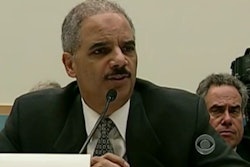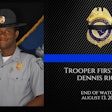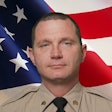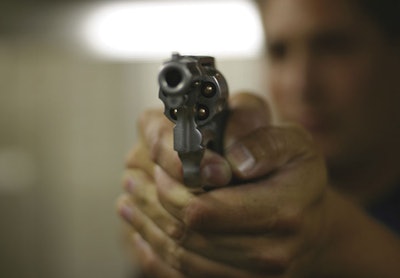 Photo: iStockphoto.com
Photo: iStockphoto.com
A black male in a white vehicle.
The description of the suspect wanted for the robbery of the Fifth Third Bank in Northbrook, Ill., wasn't detailed, but it was all Officer Tim Gramins had to go on.
In hopes that he might intercept the suspect, the Skokie (Ill.) PD officer responded to the area of Edens Expressway/94 southbound and Overton Road-a major interchange in the Chicago area. He parked and for several minutes monitored passing traffic until the sight of a white Pontiac Bonneville caught his eye. A check of the car's license plate indicated its registered owner lived on the South Side.
The white Bonneville with a black male driver warranted a second glance from Gramins, but it was the look on the man's face that commanded his attention. The split-second betrayal of fear melted into a calculated impassiveness that belied his being acutely aware of the trooper's ride. The expression was one that the 14-year veteran had become familiar with: The signature denial common to felons throughout the land.
Gramins wasted no time pulling in behind the Bonneville and keyed his mic to get other units rolling in his direction. But if Gramins was on to the driver's game, the Bonneville's driver, Raymond Maddox, was no less on to his and suddenly punched the accelerator, speeding off Edens Expressway and onto surface streets.
Adrenaline Rush
By the time Maddox turned east on Touhy Avenue, Gramins had closed the distance between them and his coordination of the pursuit was going as well as he could hope for. Then Maddox made a left turn onto Estes Avenue and things began to change for the worse.
PHOTOS: View a slideshow of the crime scene.
Maddox headed into a residential neighborhood where he made a hard right turn onto Kilpatrick with Gramins on his tail. Rounding the corner, Maddox slammed on his brakes just as Gramins was trying to broadcast the latest change in the pursuit's direction.
Caught off guard, Gramins skidded to a stop a mere 15 feet away from the Bonneville—much closer than he would have wanted. Maddox's car door flew open and his feet hit the pavement.
Throughout, Gramins had been in a reactive mode-reacting to information that he was processing based upon what was being communicated to him, first by the radio, then by the driver, a man who was himself unencumbered by the distractions of calling a pursuit or worrying about the welfare of others.
But the suddenness of Maddox's maneuver and the increasingly apparent reasons for it now registered with Gramins in the form of a surge of adrenaline and greater visual acuity.
At the sight of Maddox stepping out of the Bonneville with a Smith & Wesson 5906 9mm pistol, Gramins tossed the mic, then simultaneously unbuckled his seat belt with his left hand as he drew his .45 caliber Glock from its holster.
Maddox point-fired at Gramins as he charged toward the patrol unit. Four bullets hit the front of Gramins' squad car.
Gramins let loose with a barrage of rounds hoping that what he might lose in accuracy would be compensated for by its suppressive nature. The only thing separating Gramins and his assailant was a windshield that was fast disintegrating from ingoing and outgoing rounds.[PAGEBREAK]
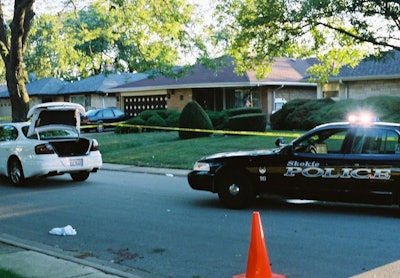 A residential street was the setting for Skokie Police Officer Tim Gramins' gunfight with a robbery suspect. Photo: Skokie PD
A residential street was the setting for Skokie Police Officer Tim Gramins' gunfight with a robbery suspect. Photo: Skokie PD
Suddenly Maddox was right on top of Gramins. Both men aimed their guns through the driver's window of Gramins' car and squeezed their triggers.
Impasse
CLICK!
If the thought that their firearms might run dry at the exact same moment had been unexpected by the men, its eventuality didn't seem to faze either. Both compensated without a second's hesitation, Maddox doubling back for the cover of his own car as Gramins exited his.
Liberating himself from the patrol car, Gramins escaped a confined kill zone and availed himself a number of tactical options for dealing with the suspect. But he'd also momentarily lost sight of Maddox, who he thought might've re-entered the Bonneville with the intent of retrieving a second weapon. Gramins positioned himself between it and the front of his patrol unit where he knelt and fed in a second magazine.
The slide of his pistol had just chambered a fresh round when Maddox was back in view along the left side of the Bonneville and re-engaging him, probably with a second handgun.
Gramins returned fire, scurrying down along the driver's side of his patrol car and around the trunk so as to get an eye forward along the passenger side of his unit.
Realizing that Maddox had moved up on his patrol car, too, Gramins ducked down on the passenger side. Seeing the Glock in lockback, he fed in a third
magazine.
Maddox and Gramins then began a deadly game of cat and mouse, firing on each other from opposite sides of the patrol vehicle. One would rise and fire as the other would duck.
Aim Better
Back and forth it went until Gramins saw Maddox sink below his visual plane again. He decided to try a different tactic. Seeing that the patrol car was canted up on the crest of the street, the officer wondered if he couldn't skip some rounds off the asphalt at Maddox.
Gramins went prone, and resumed firing under the patrol car in Maddox's direction, more point shooting than not. But as he visually tracked his shots' placement, he realized that his rounds were impacting the tire and the underside of his unit.
Not good, Gramins thought. You need to aim better.
He paused, took a breath and a second to consciously line his sights up on what he could see of Maddox's head as the man crouched on the downslope of the opposite side of the street. Slowing himself down, Gramins locked in his sights on the suspect's head and fired a three-round volley in rapid succession.
Maddox went down.
Gramins paused, peering beneath the vehicle's frame and keeping an eyeline on Maddox's prostrate form. Blood pooled about Maddox's head.
Gramins keyed his portable mic to get paramedics rolling but kept getting stepped on by the coordination of units responding to his location.
A plainwrap manned by Skokie PD detectives Jose Mendez and Jessie Barnes was the first unit on scene. Seeing the extent of Maddox's injuries, Mendez kicked the suspect's handgun to the side before handcuffing him while Barnes checked on Gramins. Gramins and Maddox were then transported to St. Francis Hospital where Maddox was pronounced dead and Gramins spent the night before being released the next day.
17 Hits
Gramins believes that the second time Maddox engaged him it was probably with a second handgun that he had, a Bersa Blue Thunder .380. But save for a few cuts to his chin from flying debris, Gramins came out of the shooting mentally and physically unscathed.
It was a different story for Maddox.[PAGEBREAK]
 Police found stacks of bills in the trunk of the car the robbery suspect was driving. Photo: Skokie PD
Police found stacks of bills in the trunk of the car the robbery suspect was driving. Photo: Skokie PD
"There were 17 total hits on his body including three fatal shots to his head, a couple to his torso, and one to his abdomen," Gramins says. "Which means that even though Maddox was mortally wounded before the head shots, he was still able to engage me.
"People don't die the way we think they do," Gramins says. "I had 17 rounds in the guy. That will teach you how critical shot placement is."
Gramins' inability to successfully place rounds in the early part of the engagement is readily understandable given both the spontaneous nature of the attack and the confined environment he'd found himself in. Still, he'd made the most out of suppressive fire.
"Early in the fight, I didn't see where my rounds were going," says Gramins. "I had a favorable backdrop but didn't have my front sight. You need to find that front sight as fast as you can.
"They always talk about getting the front sight, and it's true. I knew the rounds I shot when I was prone and perpendicular to my unit hit him because I had a good sight picture on him as he was kneeling on the other side of my squad car on the opposite side of the street," he says.
Gramins readily credits his training as the key to his survival, and he tries to convey that same kind of training to others. He emphasizes the need to take one's range and tactical training seriously and shares his "will to survive" philosophy. But in discussing the shooting with other officers, Gramins is occasionally dismayed to hear someone comment, "Shooting through the glass? Holy cow, I wouldn't have thought of that."
"Well, why not?" Gramins asks them rhetorically.
Such encounters make him wonder if police agencies are doing an adequate job of training their personnel. He also wonders to what extent officers take it upon themselves to enhance their training through their own initiative.
"I'm lucky because my SWAT training has given me more training than many other officers get, and that training comes into play," Gramins admits. "But I've also supplemented that training with outside training. I also make a point of reading books like Dave Grossman's 'On Combat' and Alexis Artwohl's 'Deadly Force Encounters: What Cops Need To Know To Mentally And Physically Prepare For And Survive A Gunfight.'"
But even with all that training and a round in the chamber, each of Gramins' available 12-round gun magazines came into play that day-and he had a mere four rounds left when the smoke cleared.
"When you run empty, you run out quicker than you think you're going to," Gramins observes. "My backup was a Glock 26, but I didn't get to it."
The Glock 26 wasn't the only weapon that didn't come into play: An SKS rifle was recovered from the Bonneville. Gramins demurs when asked if his aggressing Maddox on foot may have prevented the man from accessing the weapon, but it is something to consider.
So are the unexpected things that one can experience in a firefight. For Gramins, just getting off his first round provided a huge psychological lift. "You feel a little better once you're up and in the game," he says.
Gramins has accustomed himself to cardio training and to routinely performing "what if" scenario training throughout his work day. He hopes that other officers working patrol are as conscientious about keeping themselves mentally and physically conditioned and that they always have something at the forefront of their consciousness to fight for. For Gramins, that proved to be his love for his son.
"It was my son's birthday, and we were going to have a party for him that night," Gramins recalls. "I was determined to be there for my son, and that goal gave me all the determination I needed to come out on top."
One image stays with Gramins, who was named Illinois State Officer of the Year and one of 10 law enforcement officers selected by NAPO to visit the White House for their heroism. The image is that of a resident on the northeast corner of the street who throughout the incident was yelling his support for the officer.
"'Get this guy!' he's yelling," Gramins laughs. "'Get him! Get him! Shoot him!' I could hear him the whole time. It was comforting to know that someone was cheering me on and that I was not out there by myself. It was like having a coach on the sidelines during a game."









